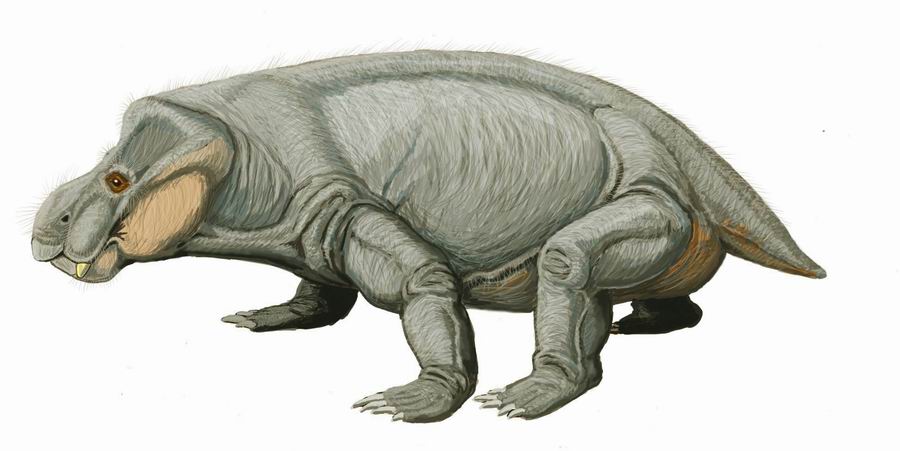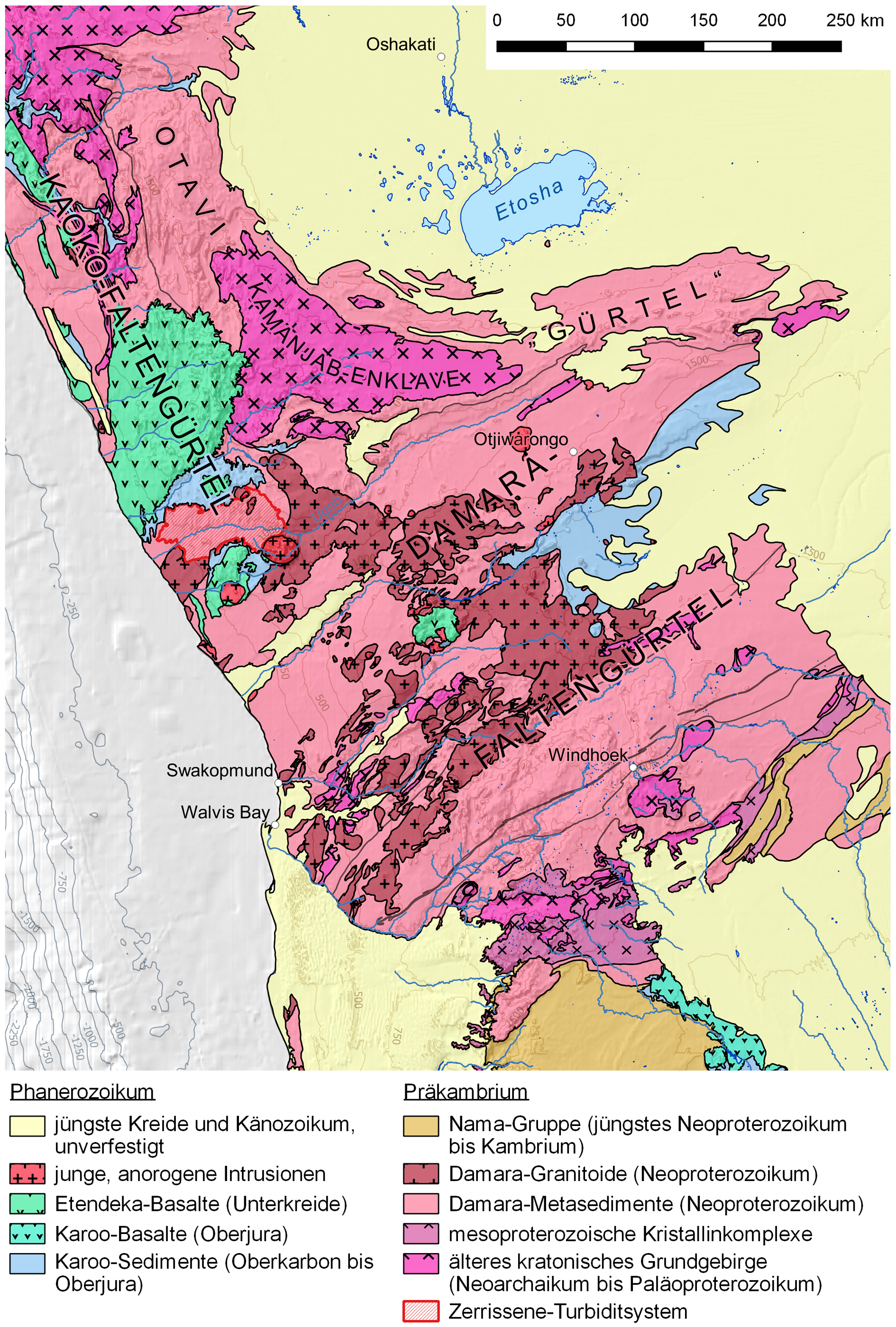|
Kannemeyeriid
''Kannemeyeria'' is a genus of dicynodont that lived during the Anisian age of Middle Triassic period in what is now Africa and South America. The generic name is given in honor of Daniel Rossouw Kannemeyer, the South African fossil collector who discovered the original specimen. It is one of the first representatives of the family, and hence one of the first large herbivores of the Triassic. Description ''Kannemeyeria'' was about in length, about the size of an ox. Although it had a large head, it was lightweight due to the size of the eye sockets and nasal cavity. It also had limb girdles which formed massive plates of bone that helped support its heavily built body. ''Kannemeyeria'' was well-adapted to living as a herbivore; it had a powerful beak and strong jaw muscles built for shearing plant material. ''Kannemeyeria'' had a massive head with unusually large openings for the eyes, nostrils and jaw muscles. It evidently tore up roots, stripped leaves from the vegetation ... [...More Info...] [...Related Items...] OR: [Wikipedia] [Google] [Baidu] |
1908 In Paleontology
Arthropoda Newly named insects Archosauromorphs Newly named basal archosauromorphs Newly named dinosaurs Data courtesy of George Olshevsky's dinosaur genera list. Synapsids Non-mammalian References {{portal, Paleontology [...More Info...] [...Related Items...] OR: [Wikipedia] [Google] [Baidu] |
Manda Formation
The Manda Formation (also known as the Manda Beds) is a Middle Triassic (Anisian?) or possibly Late Triassic (Carnian?) Formation (stratigraphy), geologic formation in Tanzania. It preserves fossils of many terrestrial vertebrates from the Triassic, including some of the earliest Dinosauromorpha, dinosauromorph archosaurs. The formation is often considered to be Anisian in age according to general tetrapod biochronology hypotheses and correlations to the Cynognathus Assemblage Zone, ''Cynognathus'' Assemblage Zone of South Africa. However, some recent studies cast doubt to this age, suggesting that parts deposits may actually be younger (Carnian) in age. History of study One of the first to study rocks of the Manda Formation was British geologist G. M. Stockley. In 1932, Stockley explored the geology of the Ruhuhu Basin in Tanzania. He called a series of layers dating from the Late Carboniferous to the Middle Triassic the Songea Series and divided it into eight units labelled K1- ... [...More Info...] [...Related Items...] OR: [Wikipedia] [Google] [Baidu] |
Ntawere Formation
The Ntawere Formation is a Middle Triassic (Anisian) geological formation in Zambia, preserving fossils of synapsids, archosaurs, and temnospondyls. Geology Several different facies are present in the Ntawere Formation, reconstructing a floodplain environment. The coarsest facies are trough cross-bedded conglomeratic sandstone full of mineral concretions. These coarse deposits formed in ancient channels such as riverbeds. Another type of facies involves thick beds of mudstone interbedding with thinner layers of fine-grained sandstone, indicating alternating low- and high-energy water flow within the channels. Graded sandstone to mudstone overbank deposits (complete with ripple marks) occur near channel deposits. Extensive successions of laminated or massive mudstone are common, often containing slickensides, calcareous nodules or layers ( marls), and/or hematite nodules. These types of thick mud/marl layers likely formed in more quiet parts of the floodplain isolated from tur ... [...More Info...] [...Related Items...] OR: [Wikipedia] [Google] [Baidu] |
Triassic
The Triassic ( ; sometimes symbolized 🝈) is a geologic period and system which spans 50.5 million years from the end of the Permian Period 251.902 million years ago ( Mya), to the beginning of the Jurassic Period 201.4 Mya. The Triassic is the first and shortest period of the Mesozoic Era and the seventh period of the Phanerozoic Eon. Both the start and end of the period are marked by major extinction events. The Triassic Period is subdivided into three epochs: Early Triassic, Middle Triassic and Late Triassic. The Triassic began in the wake of the Permian–Triassic extinction event, which left the Earth's biosphere impoverished; it was well into the middle of the Triassic before life recovered its former diversity. Three categories of organisms can be distinguished in the Triassic record: survivors from the extinction event, new groups that flourished briefly, and other new groups that went on to dominate the Mesozoic Era. Reptiles, especially archosaurs, were the ... [...More Info...] [...Related Items...] OR: [Wikipedia] [Google] [Baidu] |
Anisian
In the geologic timescale, the Anisian is the lower stage (stratigraphy), stage or earliest geologic age, age of the Middle Triassic series (stratigraphy), series or geologic epoch, epoch and lasted from million years ago until million years ago. The Anisian Age succeeds the Olenekian Age (part of the Lower Triassic Epoch) and precedes the Ladinian Age. Stratigraphic definitions The stage and its name were established by Austrian geologists Wilhelm Heinrich Waagen and Carl Diener in 1895. The name comes from ''Anisus'', the Latin name of the river Enns (river), Enns. The original type locality (geology), type locality is at Großreifling in the states of Austria, Austrian state of Styria. The base of the Anisian Stage (also the base of the Middle Triassic series) is sometimes laid at the first appearance of conodont species ''Chiosella, Chiosella timorensis'' in the stratigraphic record. Other stratigraphers prefer to use the base of magnetic chronozone MT1n. There is no accept ... [...More Info...] [...Related Items...] OR: [Wikipedia] [Google] [Baidu] |
Carnivore
A carnivore , or meat-eater (Latin, ''caro'', genitive ''carnis'', meaning meat or "flesh" and ''vorare'' meaning "to devour"), is an animal or plant Plants are the eukaryotes that form the Kingdom (biology), kingdom Plantae; they are predominantly Photosynthesis, photosynthetic. This means that they obtain their energy from sunlight, using chloroplasts derived from endosymbiosis with c ... whose nutrition and energy requirements are met by eating, consumption of animal tissue (biology), tissues (mainly muscle, adipose tissue, fat and other soft tissues) as food, whether through predation or scavenger, scavenging. Nomenclature Mammal order The technical term for mammals in the order (biology), order Carnivora is ''carnivoran'', and they are so-named because most member species in the group have a carnivorous diet, but the similarity of the name of the order and the name of the diet causes confusion. Many but not all carnivorans are meat eaters; a few, such as the fe ... [...More Info...] [...Related Items...] OR: [Wikipedia] [Google] [Baidu] |
Quebrada De Los Fósiles Formation
Quebrada may refer to: Places Argentina * Quebrada de Las Flechas, a valley in the province of Salta in northern Argentina * Quebrada de Humahuaca, World Heritage, a valley in the province of Jujuy in northern Argentina * Quebrada de Luna, village in Argentina Bolivia * Quebrada Honda, a fossil site in southern Bolivia Brazil * Canoa Quebrada, a seaside resort in northeastern Brazil Chile * Quebrada del Nuevo Reino, a village in Pichilemu, Chile Colombia * Quebrada Limas, a small river in Bogotá Costa Rica * Quebrada Grande, village in Guanacaste, Costa Rica Puerto Rico *Quebrada, Camuy, Puerto Rico, a barrio *Quebrada, San Lorenzo, Puerto Rico, a barrio * Quebrada Arenas, Las Piedras, Puerto Rico, a barrio *Quebrada Arenas, Maunabo, Puerto Rico, a barrio *Quebrada Arenas, San Lorenzo, Puerto Rico, a barrio *Quebrada Arenas, Toa Alta, Puerto Rico, a barrio *Quebrada Arenas, Vega Baja, Puerto Rico, a barrio *Quebrada Arenas, San Juan, Puerto Rico, a barrio *Quebrada Arriba, ... [...More Info...] [...Related Items...] OR: [Wikipedia] [Google] [Baidu] |
Tanzania
Tanzania, officially the United Republic of Tanzania, is a country in East Africa within the African Great Lakes region. It is bordered by Uganda to the northwest; Kenya to the northeast; the Indian Ocean to the east; Mozambique and Malawi to the south; Zambia to the southwest; and Rwanda, Burundi, and the Democratic Republic of the Congo to the west. According to a 2024 estimate, Tanzania has a population of around 67.5 million, making it the most populous country located entirely south of the equator. Many important hominid fossils have been found in Tanzania. In the Stone and Bronze Age, prehistoric migrations into Tanzania included South Cushitic languages, Southern Cushitic speakers similar to modern day Iraqw people who moved south from present-day Ethiopia; Eastern Cushitic people who moved into Tanzania from north of Lake Turkana about 2,000 and 4,000 years ago; and the Southern Nilotic languages, Southern Nilotes, including the Datooga people, Datoog, who originated fro ... [...More Info...] [...Related Items...] OR: [Wikipedia] [Google] [Baidu] |
Namibia
Namibia, officially the Republic of Namibia, is a country on the west coast of Southern Africa. Its borders include the Atlantic Ocean to the west, Angola and Zambia to the north, Botswana to the east and South Africa to the south; in the northeast, approximating a quadripoint, Zimbabwe lies less than 200 metres (660 feet) away along the Zambezi, Zambezi River near Kazungula, Zambia. Namibia's capital and largest city is Windhoek. Namibia is the driest country in sub-Saharan Africa, and has been inhabited since prehistoric times by the Khoekhoe, Khoi, San people, San, Damara people, Damara and Nama people. Around the 14th century, immigration, immigrating Bantu peoples arrived as part of the Bantu expansion. From 1600 the Ovambo people#History, Ovambo formed kingdoms, such as Ondonga and Oukwanyama. In 1884, the German Empire established rule over most of the territory, forming a colony known as German South West Africa. Between 1904 and 1908, German troops waged a punitive ... [...More Info...] [...Related Items...] OR: [Wikipedia] [Google] [Baidu] |
Omingonde Formation
The Omingonde Formation is an Early Triassic, Early to Middle Triassic (Anisian to Ladinian) geologic Formation (geology), formation, part of the Karoo Supergroup, in the western Otjozondjupa Region and northeastern Erongo Region of north-central Namibia. The formation has a maximum thickness of about and comprises sandstones, shales, siltstones and conglomerate (geology), conglomerates, was deposited in a fluvial depositional environment, environment, alternating between a meandering river, meandering and braided river setting. The Omingonde Formation is correlated with a series of formations in northwestern Argentina and the Paraná Basin in southeastern Brazil, deposited in a larger basinal area, 120 million years before the break-up of Pangea. The formation has provided fossils of several therapsids, amphibians and ichnofossils and belongs to the Cynognathus Assemblage Zone, ''Cynognathus'' Assemblage Zone. The Omingonde Formation preserves the most diverse fauna of Middle Tria ... [...More Info...] [...Related Items...] OR: [Wikipedia] [Google] [Baidu] |
Zambia
Zambia, officially the Republic of Zambia, is a landlocked country at the crossroads of Central Africa, Central, Southern Africa, Southern and East Africa. It is typically referred to being in South-Central Africa or Southern Africa. It is bordered to the north by the Democratic Republic of the Congo, Tanzania to the north-east, Malawi to the east, Mozambique to the southeast, Zimbabwe and Botswana to the south, Namibia to the southwest, and Angola to the west. The capital city of Zambia is Lusaka, located in the south-central part of Zambia. The population is concentrated mainly around Lusaka in the south and the Copperbelt Province to the north, the core economic hubs of the country. Originally inhabited by Khoisan peoples, the region was affected by the Bantu expansion of the thirteenth century. Following European colonization of Africa, European colonisers in the 18th century, the British colonised the region into the British protectorates of Barotziland–North-Western Rho ... [...More Info...] [...Related Items...] OR: [Wikipedia] [Google] [Baidu] |







